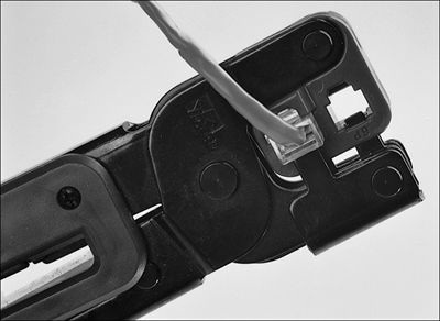Hardware Reference
In-Depth Information
Figure 17.13. Firmly squeeze the crimping tool to attach the connector to the cable.
10.
Repeat steps 4-9 for the other end of the cable. Recut the end of the cable if necessary before
stripping it.
11.
Label each cable with the following information:
• Wiring standard
• Length
• End with crossover (if any)
• ________ (a blank) for computer ID
The cables should be labeled at both ends to make matching the cable with the correct computer easy
and to facilitate troubleshooting at the hub. Check with your cable supplier for suitable labeling stock
or tags you can attach to each cable.
Cable Distance Limitations
The people who design computer systems love to find ways to circumvent limitations. Manufacturers
of Ethernet products have made possible the building of networks in star, branch, and tree designs that
Topologies
” section later in this chapter.) Strictly speaking, you can have thousands of computers on
a complex Ethernet network.
LANs are local because the network adapters and other hardware components typically can't send
LAN messages more than a few hundred feet.
Table 17.6
lists the distance limitations of various types
of LAN cable. In addition to the limitations shown in the table, keep the following points in mind:
• You can't connect more than 30 computers on a single Thinnet Ethernet segment.
• You can't connect more than 100 computers on a Thicknet Ethernet segment.
• You can't connect more than 72 computers on a UTP Token-Ring cable.
• You can't connect more than 260 computers on an STP Token-Ring cable.
Table 17.6. Network Distance Limitations




